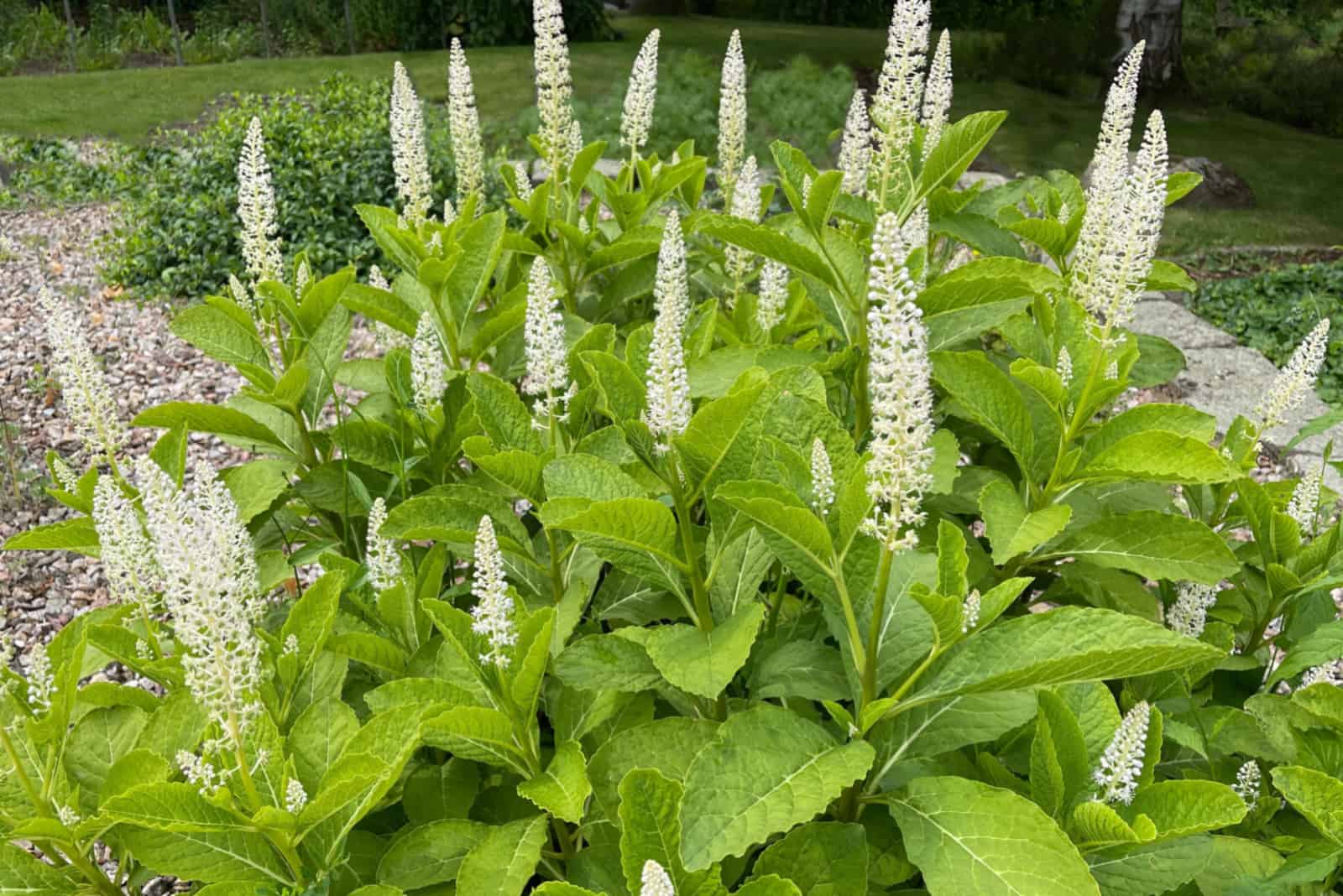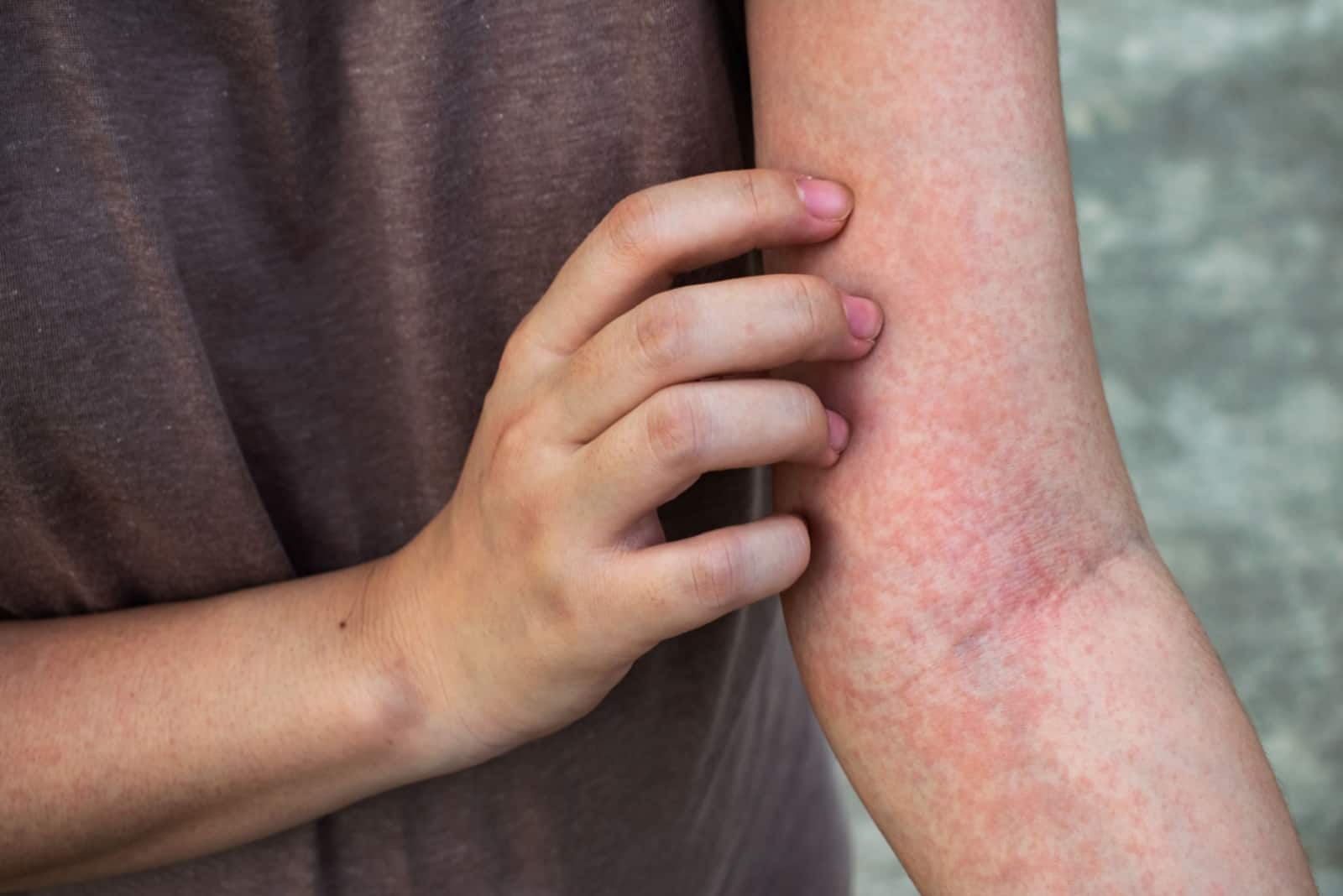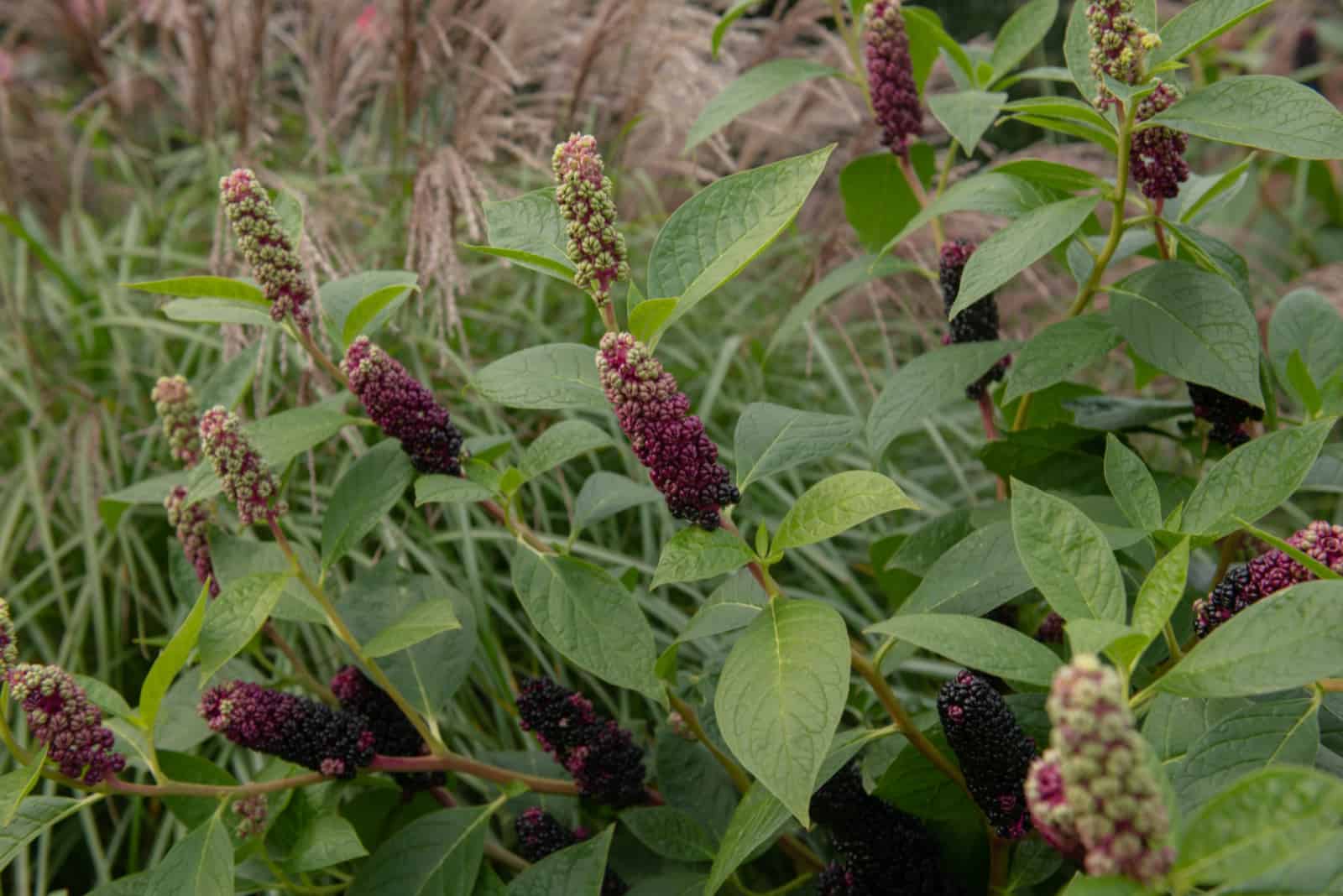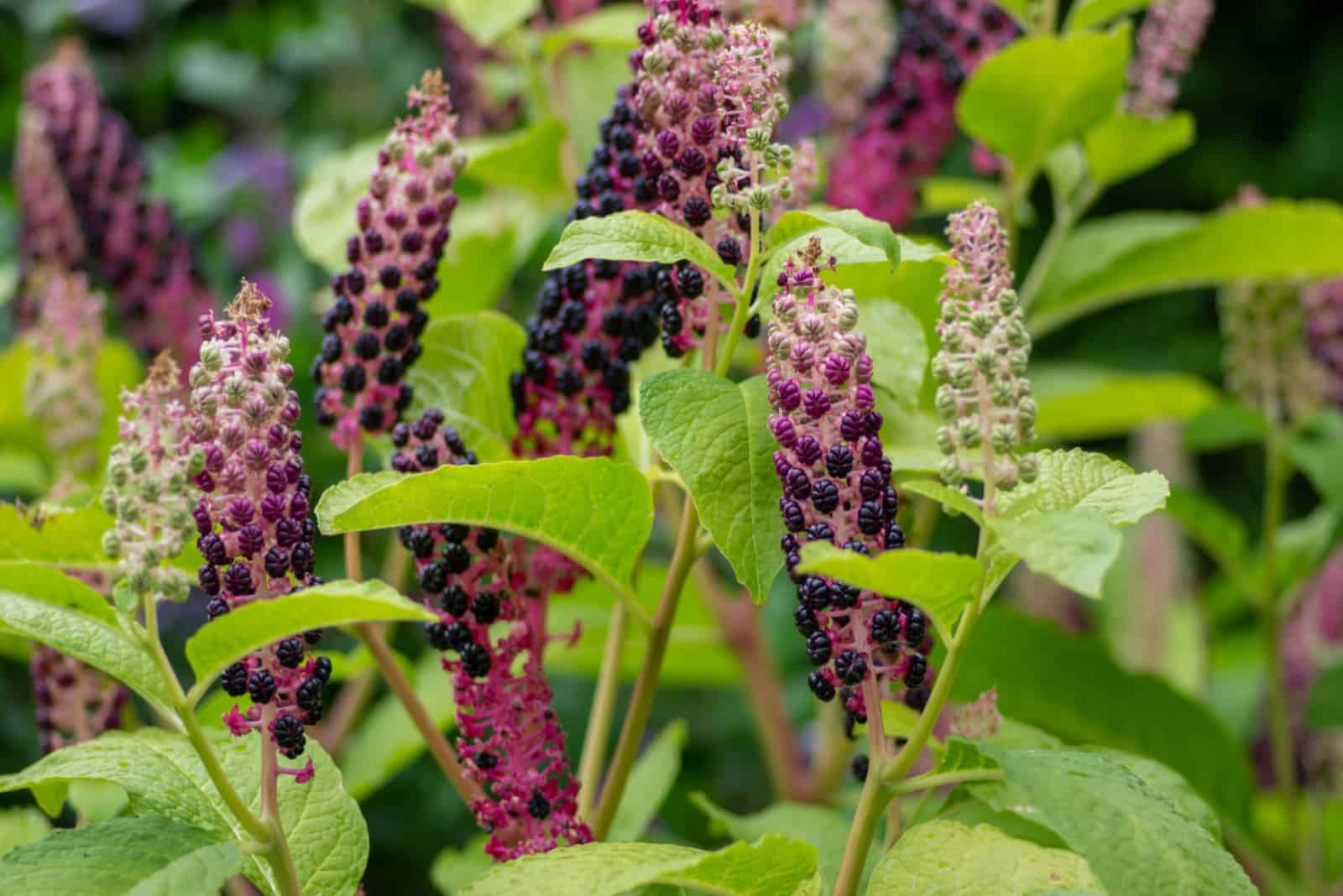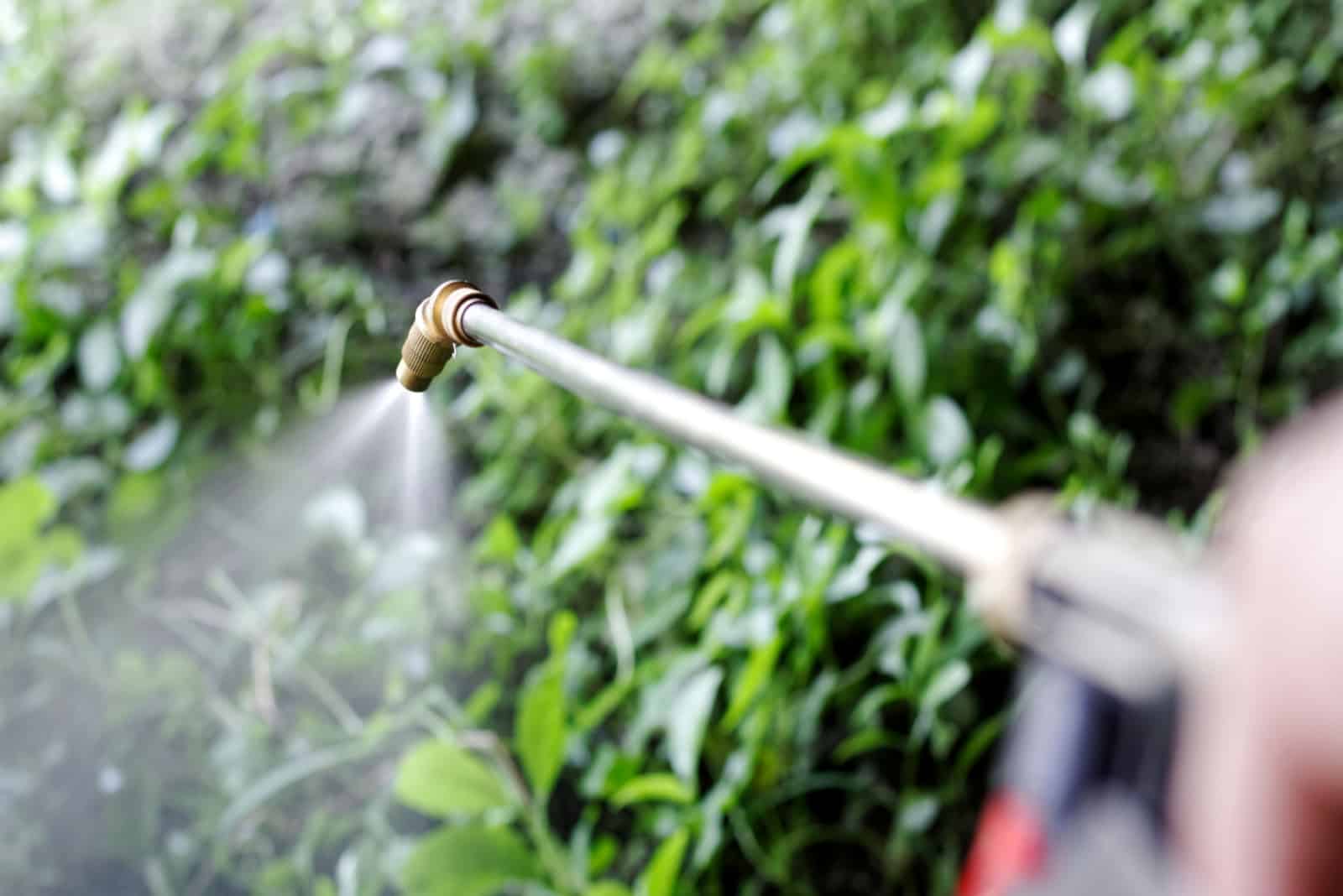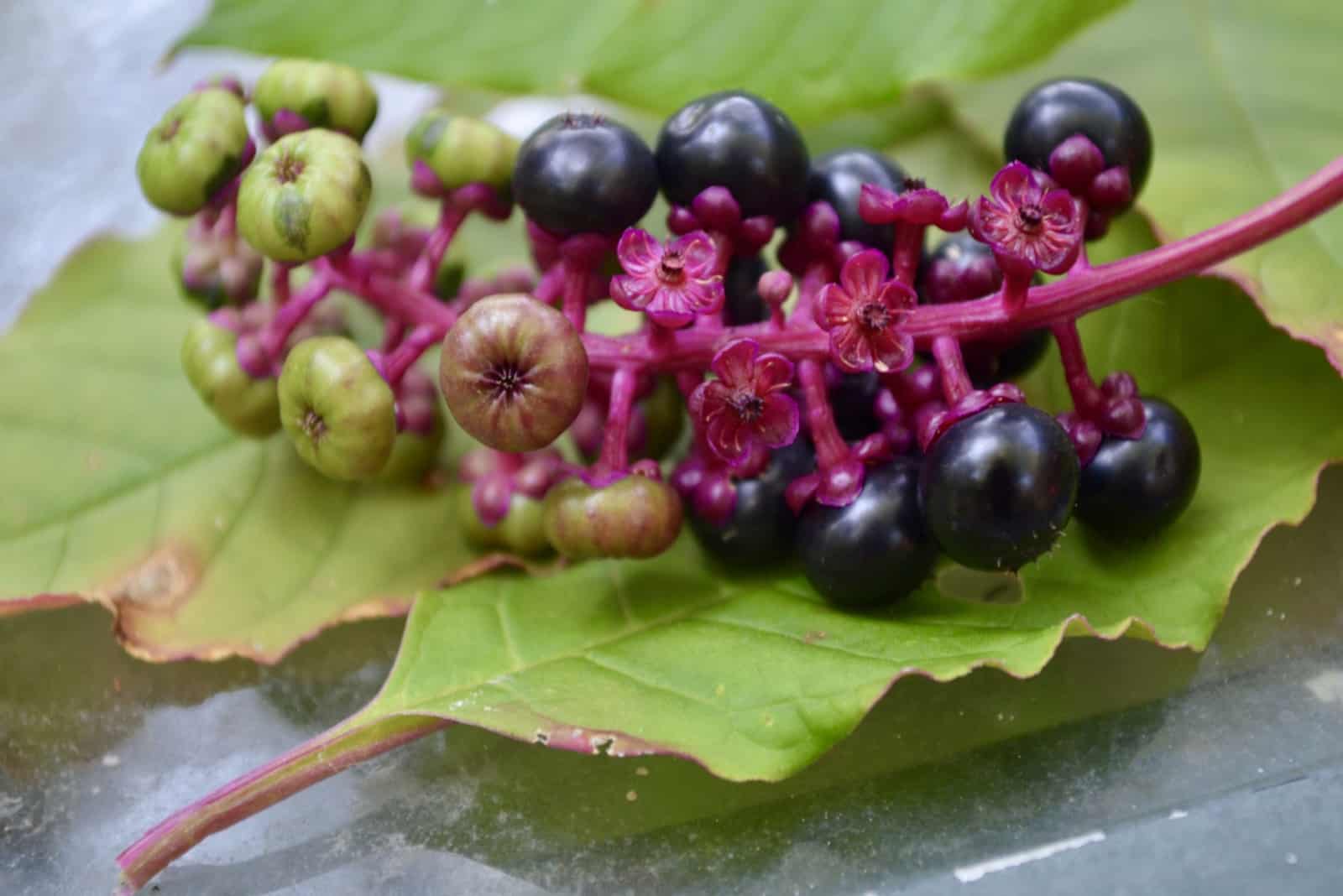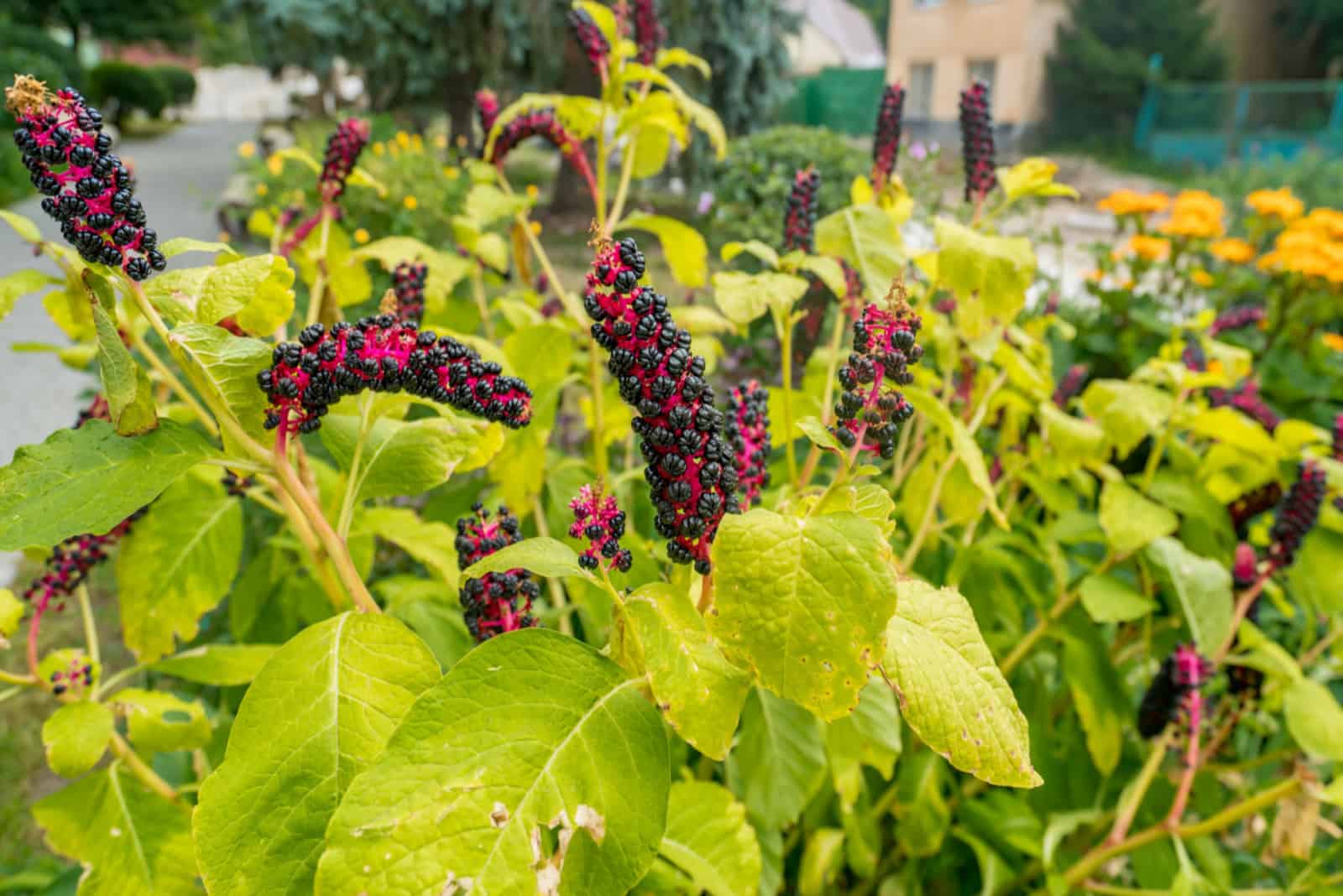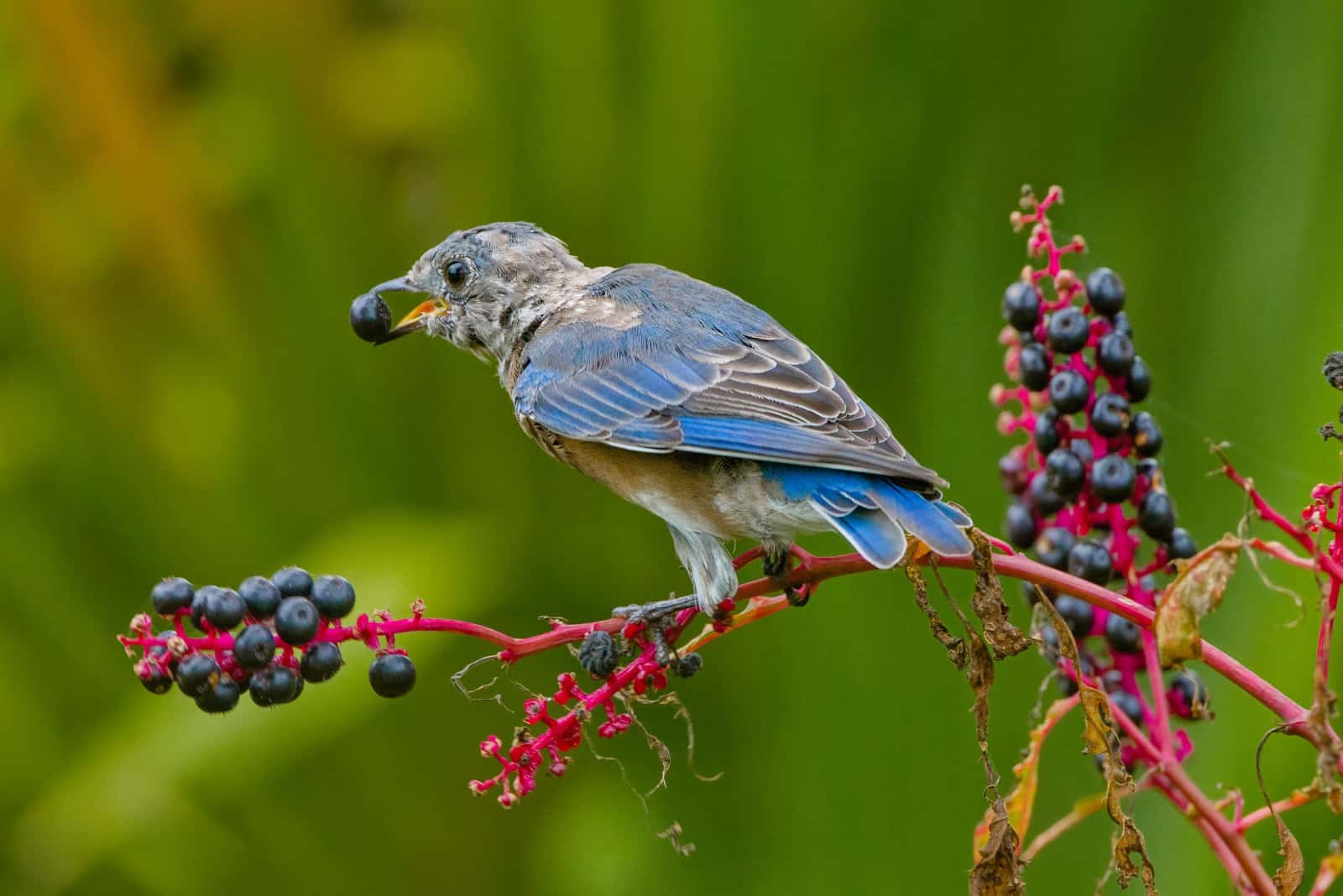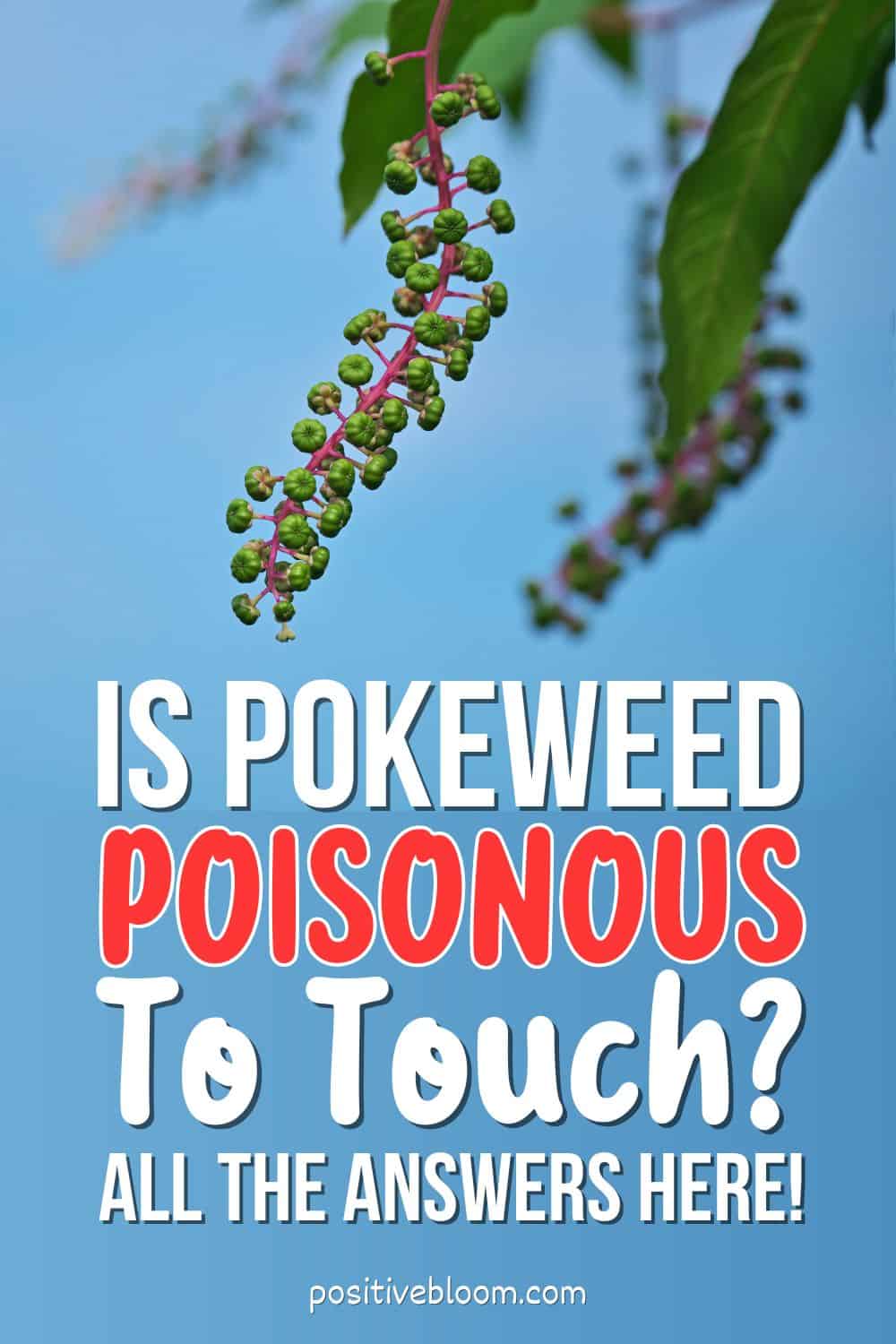You have probably seen little berries growing alongside the road or in your garden that kind of look like blueberries — these are actually pokeweed berries .
I remember always wanting to try them as a kid, but my parents told me to stay away and I never really knew why. After doing lots of research on pokeweed and other invasive plants, I finally found my answer!
So, is pokeweed poisonous to touch? Let’s find out!
Is Pokeweed Poisonous To Touch?
Pokeweed is a native herbaceous plant that grows all over the United States, and it is poisonous! It is also referred to as Phytolacca americana . It can grow in several types of soil and is quite invasive, mainly because each plant can produce up to 50,000 seeds!
There are many of these plants, and perhaps they wouldn’t cause any problems if they weren’t toxic. The seeds are typically distributed when dropping off the plant or by birds that eat them.
Although these pokeberries may look delicious, eating them is a big no-no!
But what about touching other parts of the pokeweed plant ?
You shouldn’t do that either because all parts of the plant are poisonous, especially the roots and new leaves. However, you should also stay away from old leaves, stems, unripe and ripe berries, and even the seeds.
Touching them with broken skin is far worse, as the toxins from this poisonous plant can enter the bloodstream quickly and disrupt the respiratory and digestive systems. This will be followed by numerous health issues that we will discuss later on.
If you touch pokeweed with bare hands you will get a pokeweed rash, which is similar to poison ivy or poison oak rash. You will notice redness, inflammation, blisters , and itching. Mild cases can be treated at home, while severe cases require medical attention.
Pokeweed Toxicity
So, what makes this plant toxic?
Pokeweed, which is native to North America , contains toxins such as Phytolaccatoxin , Phytolaccigenin, and Triterpene saponins .
The GI injury is caused by the saponin glycosides phytolaccatoxin and phytolacca genin, which cause fulminant gastroenteritis, vomiting, and diarrhea 2 to 4 hours after ingestion . Following large GI fluid losses, hypotension may occur. Weakness, unconsciousness, seizures, respiratory depression, and other side effects are all signs of severe poisoning.
Additionally, P. americana has proteins that are mitogenic, hemagglutinating, and antiviral. Lymphocytes and plasma cells may undergo morphologic alterations as a result of pokeweed mitogen. After ingesting or touching P. americana with broken skin, an elevated number of circulating plasmablasts and proplasmacytes, eosinophilia, and thrombocytopenia can be observed.
This is all proven by science, even though some folks might say that pokeweed is not toxic. Sure, it’s true that the native Americans have regularly used pokeweed in food and medicine, but nowadays the primary goal is making medication that relies on the effectiveness of these substances.
Toxicity is a common feature of many invasive plants so that they can protect themselves and grow anywhere without being eaten by animals. Fortunately these plants aren’t deadly for living beings – they are simply unsettling, which is why animals tend to avoid them.
Symptoms Of Pokeweed Poisoning
Cancer Root, American Nightshade , Pigeon Berry , Inkberry Coakun, Pookan Bush, Virginia poke poisoning, and Pokeroot are some of the other names for this plant, but we collectively call it pokeweed .
In addition to being skin irritants, some of the toxins can cause stomach pain, low blood pressure, headache, nausea, convulsions, vomiting, diarrhea, incontinence (loss of urinary control), seizures, heavy breathing, irregular heart rate, and muscle spasms, as well as an allergic reaction.
These symptoms are usually manifested two to six hours after ingesting pokeweed or a pokeberry .
This toxic plant interferes with medication like anticoagulants (prevent blood clotting) and antihypertensives (lowering blood pressure).
An example of anticoagulant medication would be Coumadin , and an antihypertensive would be ACE inhibitors.
Let’s take a look at some of these symptoms in detail and see what actually happens to our bodies.
Seizures
The phytolacca protein produced by the American Nightshade plant immediately lowers our blood pressure, which is followed by difficulties in breathing and cardiac distress.
The brain is deprived of oxygen as a result of this type of respiratory insufficiency, which makes seizures a potential side effect of ingesting pokeweed .
Irregular Heart Rate
As we already mentioned, pokeweed can interfere with medication that is supposed to ensure normal blood flow through the heart, veins, and vessels. When normal blood flow is disrupted it leads to irregular heart rate.
Toxin-induced blood artery constriction may result in either an increase or decrease in blood flow. This causes the blood pressure to drop and the heart rate to slow down. The heart must work harder to ensure appropriate blood supply when the exposed individual moves around, which raises the heart rate.
Muscle Spasms
Muscle spasms are also followed by low blood pressure . By lowering blood pressure and causing blood vessels to close, toxins deprive muscles of the blood-producing spasms they so desperately need.
Muscle spasms, otherwise known as muscle cramps, are involuntary contractions of the muscles — in this case, it’s almost impossible to relax the affected muscles.
What To Do After Pokeweed Poisoning
The first thing you should do is determine the severity of the poisoning — if you accidentally touched the plant and have a mild rash, you can treat it at home. However, if you have eaten a poke salad or got pokeberry all over your skin or in your eyes, immediately go to the emergency room and seek a healthcare professional for help.
You can also call poison control or animal control if your pets come into contact with this toxic plant .
Don’t induce vomiting on your own and make sure that you remember what parts of the plant you have ingested or touched. This is because different parts of the plant have different toxicity.
Ingesting pokeweed won’t kill you , though one death was reported after a small child crushed the seeds into juice and drank it.
What To Do About Pokeweed Rash
The best thing you can do about pokeweed rash is wash the affected area with lukewarm water and soap immediately after exposure to the toxic plant .
You should also change your clothes and wash them.
Whatever you do, avoid scratching your skin as it can lead to much bigger issues – such as tears in the skin and secondary infections.
You can use anti-itching ointments to ease the uncomfortable tingling and prevent you from scratching, and also apply something cold to reduce inflammation.
If the rash starts to spread or the itching becomes unbearable, immediately go to the emergency room . This also applies if you notice any chest pain or have difficulties breathing or swallowing.
What You Should Know About Pokeweed
You should first know that pokeweed is an invasive plant that can easily start growing in your own garden. You should be able to identify it and learn how to get rid of it so you can prevent possible poisoning.
We are going to also cover some of the traditional and modern uses of pokeweed in medicine, and in which cases it’s ok to eat a pokeberry !
So, let’s dive in!
Pokeweed Identification
The pokeweed plant can be quite harmful if consumed, so it’s crucial to be able to recognize it and make sure you get rid of the right plant.
Imagine if grapes or blueberries start growing next to a pokeweed patch; it would be quite difficult to tell which was which.
You should first examine the leaves of pokeweed plants to identify them accurately. The leaves range in length from 5 to 10 inches and have an oval shape with a rather smooth texture. They are dark green on the outside and pinkish on the inside.
Before the plant turns into pokeberries or the actual fruit, it typically produces green- white flowers .
You can also look at the plant’s height, which can reach up to 10 feet tall. Their distinctively blood-red stems can also be used to identify them.
The pokeweed plant has a very long, white taproot that has the appearance of being fleshy, so even though you might not be able to see any pokeweed roots , you can easily recognize the plant once you have dug it out.
Finally, you can examine the pokeweed berries , which grow similarly to grapes. As is the case with pokeweed plants, they develop in groups and hang from the red stem.
How To Get Rid Of Pokeweed
You can get rid of pokeweed with a variety of techniques, including digging the plant up, applying weed killer, and even repeatedly cutting it. Choose the option that suits you best.
1. Use Your Hands
You won’t be needing any special gardening equipment for this — just some protective clothing and goggles to protect you in case the pokeweed sap bursts and causes eye irritation.
Similarly to harvesting carrots, picking a plant only requires you to grip it by the base and pull it straight out. You will know you have done it right when you start noticing taproots and thin roots.
This method might not be the ideal choice for removing pokeweed if your soil is a dense clay because it works best in light soils.
2. Dig Out The Pokeweed Plant
This removal method works best for much larger plants that can’t be pulled straight out of the ground due to how compact the soil is.
You’ll need a few gardening tools, including a rake, safety gloves, a wheelbarrow or cart, a garden fork, a soil screen, a garden hoe, and a tarp sheet.
Start by removing the small shoots around the base of the plant and digging around it. Place the plant on a tarp sheet to let it dry out and remove any seeds or berries from the soil.
3. Cutting Down The Pokeweed Plant
With this approach, the pokeweed must be continuously trimmed and checked to determine if it has started growing again, but ultimately the taproots will deplete their energy and stop expanding.
To cut the plant you will need gardening shears and proper gear to prevent any skin contact with the berries.
To stop the berries from spreading on the ground while cutting, you must first remove them all and place them in a waste bag (berries contain the seeds through which the plant reproduces). Then, either cut them with gardening shears down to the plant’s base or simply mow over them with a lawnmower.
4. Apply Weed Killer
Applying weed killer is the simplest way to get rid of the pokeweed plant if you’re short on time or the soil is too compact to dig it out by hand.
There are many ways to apply weed killer depending on the stage of plant development: if the plant is young, weed killers may totally remove it; nevertheless, larger plants with more deeply ingrained roots may cause problems.
Weed killers are usually applied after the plant has been effectively dug out so that they can prevent regrowth . Wear protective gear when using herbicides because some of them may cause cancer and have other negative health effects.
If you use a glyphosate herbicide such as Roundup Max Control, use at least 2 liters of water to dilute it. Your pokeweed plant should be ready for the rubbish bin 10 days after you apply this to the leaves.
Applying distilled vinegar is another option because it has natural acid that can burn the roots and stop growth.
Traditional Medical Use
Native Americans have used pokeweed as an emetic (to encourage vomiting), and as a purgative (to stimulate bowel movement). It was commonly believed that P. Americana naturally cleanses the body.
Pokeweed has also been used for treating diphtheria, syphilis, painful menstruation, skin diseases, scabies, and so on. As it’s a toxic plant , using pokeweed for medical purposes requires special training.
Some of the parts they have used include:
• Leaves — cathartic and purgative
• Root wash — for swellings or sprains
• Tincture of the root — primarily for lymphatic disorders, skin conditions, arthritis, tonsillitis , edema, and cancer
• Berries — consumed for arthritis without chewing on the poisonous seeds. On the first day, one is taken, the second, two, up to seven, and then back to one
• Ash from the plant — it’s potassium-rich and used for cancer
• Root poultice — breast abscesses are treated with a poultice made from the mashed, roasted root in ashes. Also used in the treatment of rheumatic pain and swelling
Modern Medical Use
Surprisingly, it is scientifically proven that pokeweed can be beneficial to our health despite its toxicity. It was declared that it is similarly as toxic as other pharmaceutical drugs that are prescribed on a regular basis.
Furthermore, the PAP protein ( pokeweed antiviral protein ) that is usually extracted from the leaves has shown significant improvements in skin and is able to prevent and treat viral infections such as herpes or HIV.
Cancer Treatments
The anti-tumor, anti-inflammatory, and immunostimulant activities of the compounds appear to be the main mechanisms by which the anti-cancer effects function . The phytolacca toxin ‘s antiplasmodial or cytotoxic components may provide additional assistance in the battle against cancer.
Additionally, even though they have not been proven to be a cause or contributing factor to cancer, several constituents’ antibacterial, antiviral, and antithelmetic characteristics may contribute to their anti-cancer effect.
It all comes down to the PAP protein, which has the ability to inhibit a ribosome (which is an organelle found in almost every cell in our body crucial for protein synthesis). Some cancers such as leukemia, breast cancer, and melanoma, are linked to ribosome mutations.
So, if we utilize PAP protein to inhibit ribosomes, there will be no mutation!
In 1993, it was noted that the PAP protein was genetically engineered to bind to the CD4+ immune cells, which are the cells that HIV primarily attacks.
Bear in mind that these are all case studies that have been done throughout the years, which means that there is no evidence that consuming pokeweed would have the same effect. This plant is promising for further drug development and new drug designs.
Tonsillitis
Pokeweed , capsaicin, lignum vitae, and other natural components are present in trace levels in a variety of homeopathic remedies used to treat tonsillitis .
They are thought to soothe pain, inflammation, and scratchiness while lubricating and maintaining the mucous membrane of the throat.
Anti-inflammatory For Skin Conditions
Some of the constituents in the taproot, such as saponins and triterpenes from the berries, have shown significant anti-inflammatory effects.
Even though this is sort of paradoxical because the pokeweed can cause a harmful rash, it seems that people have used this plant to treat eczema, psoriasis, and scrofula.
However, in some cases it served as an anti-inflammatory remedy to reduce swelling and relieve pain.
Food Uses
Food uses? But I thought this plant was toxic?
Well, it is. However, with the right amounts and proper cooking you can use it to make some delicious pies and salads!
Young plant leaves are occasionally harvested as a spring green herb and repeatedly blanched before consumption. Shoots can also be eaten as a replacement for asparagus after being blanched with many changes of water.
I personally would not recommend consuming this plant on a daily basis as the stakes are so high!
You can also create a beautiful magenta dye using pokeberries , though it washes out quickly. There is also a myth that ink made out of pokeberries was used to sign The Declaration of Independence!
Frequently Asked Questions
1. What should I do if I have touched pokeweed?
If you touched pokeweed , you should immediately wash the affected area with lukewarm water and soap. The longer you wait, the more time there is for all of the toxins from the plant to absorb into your skin and reach your bloodstream.
You can also apply calamine lotion for healing and drying damaged skin. In a severe case , go to the emergency room and seek professional help.
2. Is pokeweed toxic to humans?
Yes, pokeweed is toxic to humans and pets – especially if ingested in large amounts.
In humans, it can cause pain, low blood pressure , headache, nausea, convulsions, vomiting, diarrhea, incontinence (loss of urinary control), seizures, heavy breathing, irregular heart rate, and muscle spasms.
The lethal dose is different between young and adults. For instance, it would take about 17 berries to kill an adult person, whereas it would only take two berries to kill a small child.
So be careful and warn your kids not to eat any berries that they stumble upon!
3. What is pokeweed good for?
Surprisingly, it is scientifically proven that pokeweed , even though it’s toxic, can be beneficial to our health. Some of the substances, such as the PAP protein and saponins, can have anti-cancer and anti-inflammatory effects.
Though it may seem strange, in some folk medicine pokeweed is used to treat skin conditions.
In addition to this, pokeweed can be used to treat tonsillitis , swelling of the throat and nose, painful menstruations, and tender breasts. However, I should warn you that the proper dosage is crucial because there is a thin line between pokeweed being beneficial and harmful!
To Sum Up
I hope we have provided enough information to answer the question, “is pokeweed poisonous to touch?”.
I would personally advise you to avoid touching and eating this plant at all costs! If you are interested in its healing abilities, talk to a doctor or a herbalist about finding the proper dosage and using pokeweed as a natural remedy.
Sure, there will always be folks that will tell you it’s okay to eat this plant; however, we all have different bodies and can never know how we will react to the toxins in pokeweed .
So, don’t poke the pokeweed !
Until next time!
Like this post? Share or pin it for later!

